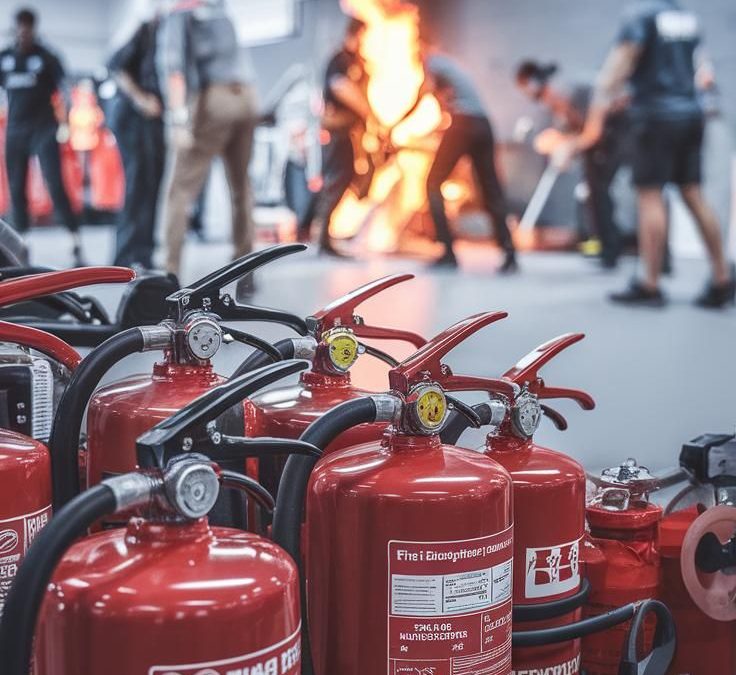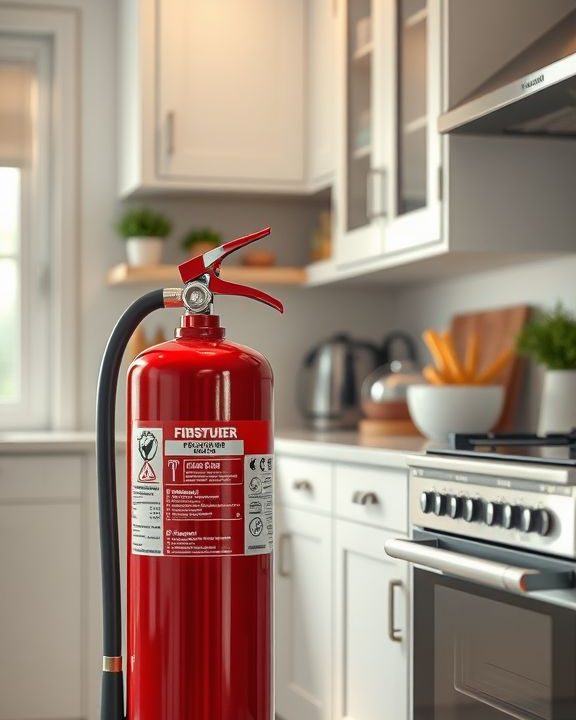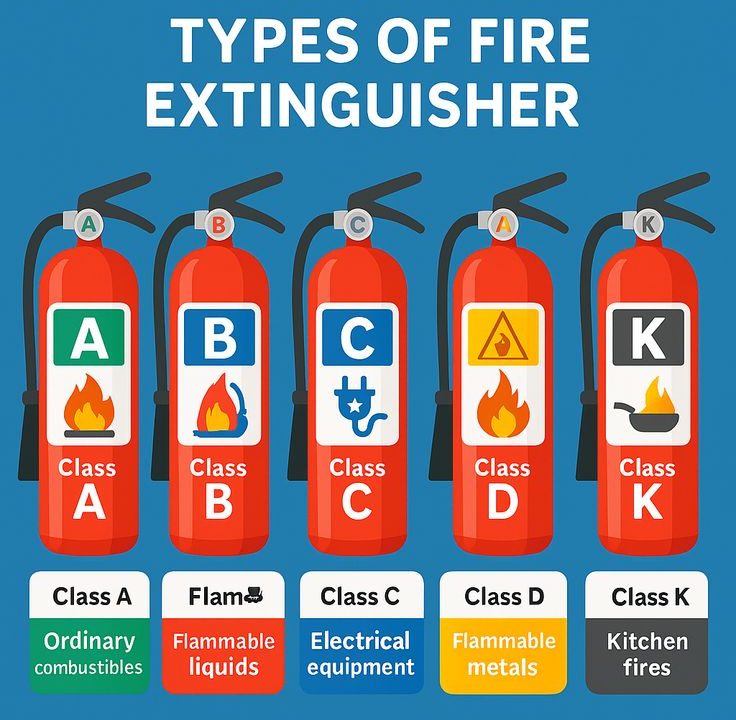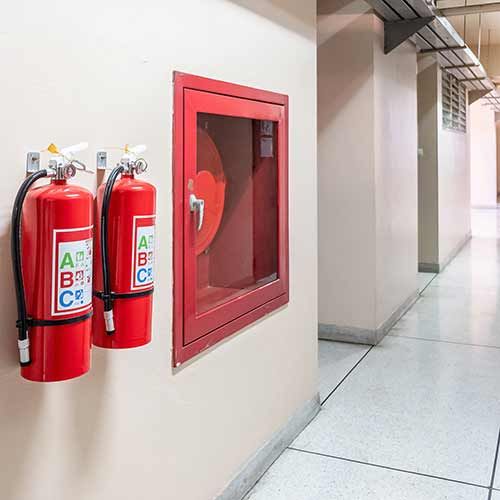The Ultimate Guide to Fire Extinguishers: Types, Use, and Maintenance Tips

A Step-by-Step Guide to Using a Fire Extinguisher Safely
August 4, 2025
How Often Do You Need to Replace Your Fire Extinguisher?
October 1, 2025The Ultimate Guide to Fire Extinguishers: Types, Use, and Maintenance Tips
When you are making dinner and you get flames in your stovetop. Are you familiar with what fire extinguisher to take? Would you even know how to use it well?
Fire crises are not timely, and having the right information could make the difference between a minor incident and a disaster.
This is an excellent source of information on using the fire extinguishers and the maintenance of the extinguishers. You can find helpful details to keep your home and loved ones safe by learning what the best fire extinguisher to purchase is or by learning the types of fire extinguishers and how to use them at work.
Key Takeaways:
- ABC fire extinguishers are the most versatile home fire extinguishers.
- PASS technique is key to using the fire extinguisher correctly in an emergency.
- The effectiveness of fire extinguishers requires monthly inspection and annual professional servicing.
- Do not use wrong extinguishers to extinguish an electrical fire to prevent the risk of being shocked.
- Good disposal of old units by empowered dealers is environmentally safe and secure.
What is a Fire Extinguisher?
A fire extinguisher is a firefighting equipment used to extinguish fire in an emergency. They operate by eliminating at least one of the three components of the fire triangle: heat, fuel, or oxygen. There are different sizes and formulations of modern fire extinguishers like, Dry Powder Fire Extinguisher, CO2 extinguisher, etc. Each is specifically designed to fight a specific type of fire effectively.
Understanding Fire Extinguisher Types: Which One Works Best on Different Fires?
The 4 Main Types of Fire Extinguishers
- Water-Based Extinguishers (Class A)
Suited to normal combustibles such as wood, paper, and cloth. These are operated by lowering the temperature of the burning material to a level below the ignition temperature of the burning material.
- Carbon Dioxide (CO2) Extinguishers (Class B and C)
Best with electrical fires and flammable liquids. CO2 replaces oxygen and does not leave a residue, so it is ideal with sensitive equipment.
- Dry Chemical Extinguishers
Dry powder fire extinguisher is the most popular ABC fire extinguisher. These all-in-one units deal with Class A (ordinary combustibles), Class B (flammable liquids), and Class C (electrical) fire by breaking the chemical reaction chain.
- Foam Extinguishers (Class A and B)
It works on ordinary combustibles and flammable liquids. The foam forms a barrier that helps to keep the vapors off the ignition sources.
Fire Extinguisher Classes and Uses
Understanding the 3 types of fires helps you choose the right extinguisher:
- Class A: Ordinary combustibles (wood, paper, textiles)
- Class B: Flammable liquids (gasoline, oil, grease)
- Class C: Electrical equipment (appliances, wiring, motors)
- Class D: Combustible metals (rarely found in homes)
- Class K: Cooking oils and fats (commercial kitchens)
Steps of Using Fire Extinguisher: The PASS Method
How to use a fire extinguisher: The PASS Method.
- P – Unscrew the safety pin on the handle
- A – Aim the nozzle at the bottom of the flames
- S – Press the handle and spray the agent
- S – Sweep the bottom in a sideways direction and keep the fire at the bottom of the flames.
You should maintain a distance (6-8 feet) and ensure that you have an escape route behind you. Assuming that the fire does not abate in the near future or re-emits, evacuate and contact the emergency services as soon as possible.
Fire Extinguisher Sizes: Selecting the appropriate Capacity.
The sizes of portable fire extinguishers usually vary between 1kg and 9kg:
- 1-2kg: Ideal in vehicles and in small areas.
- 4-6kg: domestic and office-use standard.
- 6-9kg: Commercial work and larger field.
For most homes, a 2-4kg ABC fire extinguisher provides adequate coverage for common fire risks.
How Often Should a Fire Extinguisher Be Inspected?
No, checking fire extinguishers regularly is not only advised but also necessary to maintain the safety of your equipment when there is life at stake.
- Monthly:
A monthly visual inspection should be as normal as checking the batteries of smoke detectors. Ensure nozzles are not obstructed with rubbish or nesting insects, ensure the unit remains firmly in place in its mounting area, and ensure free entry without any obstruction.
- Annual inspection:
Let professionals inspect the inner components, the pressure level, and the quality of the chemical agents. These are professionals who can see problems that cannot be seen using the eye, like internal corrosion, degradation of a valve or chemical deterioration.
- In addition to routine checks:
Check after any physical impact and extreme temperature exposure, or fire incidents in their vicinity. Through correct maintenance, you increase the life of fire extinguishers and maintain the best performance of the equipment in the event of an emergency.
How Long Does a Fire Extinguisher Last?
Most fire extinguishers have a lifespan of 10-12 years with proper maintenance. However, several factors affect longevity:
- Environmental conditions (humidity, temperature extremes)
- Usage frequency and handling
- Quality of manufacturing and materials
- Regular maintenance compliance
What Causes Fire Extinguishers to Fail?
Common failure points include:
- Pressure Loss: Gradual leakage reduces effectiveness
- Corrosion: Moisture damage to internal components
- Clogged Nozzles: Debris blocking the discharge path
- Expired Agents: Chemical breakdown over time
- Physical Damage: Dents or cracks compromising integrity
When and How to Replace Your Fire Extinguisher: Safety Tips
Being aware of how often to change your fire extinguisher may save your life in the case of an emergency. Change when the pressure gauge is red, which means that the pressure is not high enough to discharge.
- Corrosion, rust, and physical damage (dents) affect the integrity of the unit, and it must be replaced immediately. Partial discharge is replacement in all cases. Do not suppose an extinguisher that is only half full is going to perform satisfactorily.
- Internal problems (e.g. chemical degradation or valve issues) that are not visible to the naked eye may be uncovered during annual professional inspection. Above all, respect expiration dates which are usually printed on the label of a unit, since chemical effectiveness and pressure retention can vary with age.
- In replacement, you can select certified units, which are in accordance with your fire risks. Old units should also be disposed of by trained dealers who are certified to dispose of the pressurized containers, never dump them in regular garbage.
To get the best fire extinguishers Sri Lanka people are assured to buy the professional varieties which are of local standards in terms of safety and are properly certified to use in the country with relevant certification papers.
Fire Extinguisher Training: Building Confidence
Effective fire extinguisher training should include:
- Hands-on practice with different extinguisher types
- Understanding fire classification systems
- Learning when NOT to fight a fire
- Evacuation procedures and emergency contacts
- Regular refresher sessions
Maintenance Tips for Optimal Performance
Monthly Check Pressure levels, check damage, and check accessibility.
Annual Professional Service Schedule all-inclusive maintenance with internal check-up and pressure test.
Proper Storage Keep extinguishers in locations where they are readily available without being exposed to heat and other possibilities of damage.
Frequently Asked Questions
- Which kind of fire extinguisher will I purchase to use at home?
An ABC fire extinguisher will be your best selection in most homes. These all-purpose units deal with the three most prevalent types of fires: ordinary combustibles (Class A), flammable liquids (Class B), and electrical fires (Class C). A 2-4kg is large enough to cover residential purposes.
- What do I do with a fire extinguisher?
Use the PASS technique. Pull the safety pin, Aim at bottom of flames, Squeeze the handle, Sweep side to side. Keep 6-8 feet apart at all times and have a way out behind you.
- What should be the frequency of checking / replacing my fire extinguisher?
Visual inspection of pressure gauge, physical condition and accessibility monthly. Professional service once yearly and replace part after 10-12 years or when the pressure gauge enters the red zone.
- What is the difference between Class A, B and C fire extinguishers?
Class A is regular combustible (wood, paper), Class B is a flammable liquid (gasoline, oil) and Class C is an electrical fire. To be as versatile as possible, ABC fire extinguishers will provide all the three functions within a package.
- Is it possible to apply a fire extinguisher to electrical fires?
Yes, only a fire of electrical nature should be extinguished with CO2 or dry chemicals. Electrical fires should not be put out with extinguishers that have water since this puts an individual at risk of electrocution and spreads the fire.
Conclusion
One example of fire fighting equipment is a hand-held fire extinguisher that is used to contain or extinguish fire in case of an emergency.
These useful safety devices act by depriving all three components of the fire triangle, heat, fuel or oxygen, or one or two. The range of the modern fire extinguisher equipment is really great; this means that some of them are specially made to fight a certain kind of fire.
ProTip: Make a list of fire safety items at your home or workplace (notably monthly extinguisher checks, planning escape routes and emergency contact information). To get quality dry powder fire extinguisher products that are up to professional standards, designed to provide reliable emergency response in a home or small office setting.




